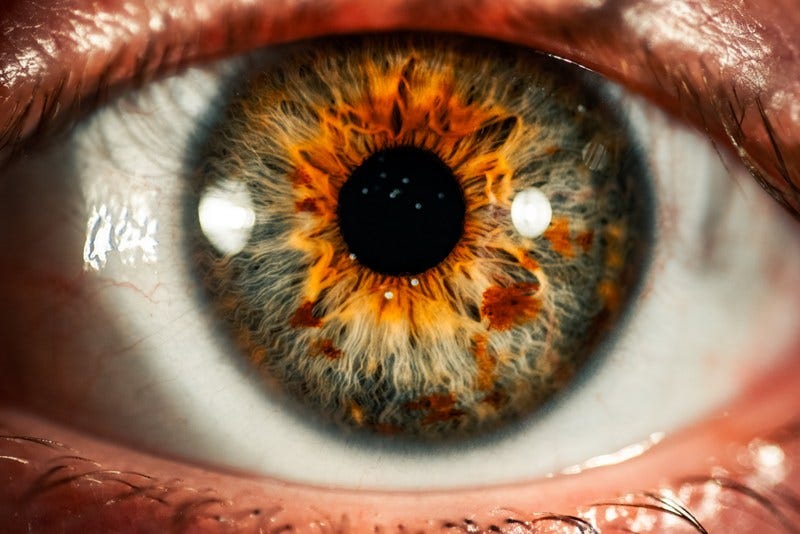Hello! This is Everything Is Amazing, a newsletter about the science of curiosity, attention & wonder, and all the hidden worlds around us waiting to be discovered, if only we learn the best ways to look for them…
(It’s also about ideas. Mostly good ones! But occasionally alarmingly horrible ones. That’s you warned, I hope.)
Today, we start season 5 of this newsletter! 🥳🥳🥳 Yes, after my laptop-related disaster of last week, I am up and running again, as this somewhat rubbish photo illustrates:
I’ve heard it said that giving technology human names is the first sign of madness, so with that in mind, Ermintrude says hi! (Ermintrude is a low-end professional gaming laptop. Main reason: they’re built to be unusually tough, so that should keep this newsletter safe from my hapless clumsiness going forward.)
So, without further preamble, and by way of introducing this season’s theme of the fascinatingly super-weird world of colour (as outlined here), I’d like to ask - have you ever had the feeling that you’re really special?
Narcissism? Pompous individualism? Ego gone mad?
Certainly not! Or at least, not necessarily. In the technical sense, you absolutely are special. You’re a human recipe that will never be exactly repeated. That particular way you think, those certain way you bring your personality to bear on everything around you, that positive role you have the chance to play in everyone else’s life? They’re one-offs.
Whatever. So far, so inspirational poster. What we really want to know: is there something tangible and real and measurable that makes us exceptional in some way? Like, some talent or behavioural quirk, some as-yet untapped potential that we can put to fantastic use? Or even for being a bit more interesting at parties?
This is a topic upon which some folk (particularly us blokes) can sound deeply tiresome and self-obsessed - but this urge to feel different is still a basic human need. We all feel it, deep down, beyond the noisy self-criticisms and fear-powered self-sabotaging. We know there’s something down there, and that it’s the work of our lives to find it, tap into it and - at last! - fulfil our human potential.
But what if you didn’t have to search? What if you saw it everywhere you looked, every single day?
Say you’re out for a walk in the park with your practical-minded friends on an unremarkable afternoon, and they’re busy ignoring all that unremarkableness, everyone chattering away, collars raised against a sharp breeze that speaks of incoming rain, everyone with their head down, no reason to dawdle.
But you? As usual, you’re way at the back, lingering - and rapt. You can’t stop looking at everything around you, at how beautiful and rich and strange it all looks, so alive in the textures and colours that flood your senses…
As usual, you burn with the urge to yell “HOLY CRAP, CHECK THIS OUT” - and you know from bitter experience that it’d be a waste of time.
Your friends are used to your “quirkiness”. You’ve always been a bit too wide-eyed, head in the clouds, enthusiastic about the most “boring” things. It’s adorable and entertaining, if a bit socially embarrassing at times. But hey, they forgive you. You’re just a daydreamer (and entirely harmless, they assure others).
You know this is how they regard you - and it’s so frustrating. You know this isn’t just “in your head” - I mean, sure, it is in your head, but not in the modern sense of it being entirely imaginary and therefore allegedly inconsequential in its utter unreality. (“Made-up stuff is rubbish. Get real!”)
You know this is something profound and tangible, and you know this isn’t about you, it’s about how other people are missing how amazing everything really is - but you just don’t know how to express it, in a way they can understand.
What do you do?
Well, you could try painting.
“I always felt like I was living in a very magical world. I know children say that, but for me, it was like everything was hyper-wonderful, hyper-different. I was always exploring into nature, delving and trying to see the intricacies, because I’d see so much more detail in everything. Someone else might look at a leaf or a petal on a flower, but for me, it was like a compulsion to really understand it, really see it, and sometimes spend a lot of time on it. And I just wanted to paint and portray everything that I was seeing.”
- artist Concetta Antico, quoted in The Guardian
Through the eyes of non-artists like me - OK, that’s a lovely way of putting it, but come on, get scientific please. Isn’t this just a fancy way of saying “I have a really great creative imagination”? No disrespect, but isn’t rhetoric like this just stringing beautiful words around something too mysterious to define, and - um, well - effing the ineffable?
One of Antico’s students, a neurologist, didn’t think so. They emailed Antico a science paper about a rare eye condition related to the colour-blindness that Antico’s daughter had recently been diagnosed with. Intrigued, the artist contacted the team of scientists that wrote the paper - and shortly after, Antico took a saliva test that confirmed she had a rare genetic mutation in her eyes.
Take another look at that painting up there, by Antico. As gorgeous as it is, isn’t it also a bit…fanciful? Like when someone overdoes it with their Instagram filters? It’s beautiful, certainly, but if every tree looked like that, shimmering against a sky as alive with colour as the Northern Lights, we’d just stand around all day, our mouths agape?
Well, they don’t look like that. Obviously. Any fool can use their eyes.
But what if they do look like that- and only people like Antico can see it?
Our ability to see colours is astonishing.
It wasn’t always this way. Today, almost all non-primate mammals have more limited colour vision than we do. But sometime in the evolution of our species, it seems we underwent a big visual upgrade - and it could have a lot to do with something with the splendid name of Nocturnal Bottleneck Thesis.
Back in times when our primate ancestors weren’t the dominant predator, it made sense for them to hunt under cover of darkness. This behaviour went on long enough that it induced physiological changes in them - in particular, a refining of their low-light vision and a heightening all their other senses.
One of the great “wow!” experiences of my own childhood was the day I realised that, in essence, I have two pairs of eyes. There’s the pair that let me function in the modern world, helping me avoid being run over when I cross the street, to skewer delicious food with my fork, to…only trip over things because I’m naturally clumsy, and so on.
I could certainly look after my eyes better - in particular, taking a few minutes a day to refocus them on the horizon, to stretch those muscles the other way for a change. But on the whole, my “normal” eyes do their job so competently I hardly notice it happening. (Apart from when I can’t find my spectacles because I’m not wearing my spectacles - a problem that modern science has yet to address and it’s just not good enough, quite frankly.)
Yet there are my other eyes, which are just like your other eyes - and they only come out at night.
Low-light or night sight goes by the scientific name of scotopic vision - from the Greek skotos, meaning "darkness". It’s hard to imagine it exists when you first turn off your torch during a night walk. You blink and blink, and - nothing, just a slowly fading blaze of afterimages.
But if you avoid bright light for long enough (forty minutes for the maximum effect), you’ll see a world transformed.
A good tip for stargazing: if you’re looking at something so dim that you think you’re imagining it, look away, just to the left or the right, so the object falls into your peripheral vision - and if it’s really there, you’ll see it. The reason is the same mechanism behind our night vision: the photoreceptor cells in our eyes that scientists call “rods” for exactly the reason you’d expect.
Rods perform brilliantly with just the tiniest scatter of incoming photons - and there are a lot more of them at the corners of our eyes, compared to the middle of them (the fovea centralis, which you’re using to read this newsletter right now - here’s the science on that).
Only thing is: rods are terrible at perceiving colour, and in particular, wavelengths longer than about 640 nm, which is where we (literally) see red. The best colour rods can manage is the greeny-blue of 498 nm, which is why the military prefers that particular shade for their computerised displays in vehicles used in night operations.
So, turn off all the lights, wait in the dark for a while, and you’ll slowly see a world emerge that’s almost entirely black & white.
This, perhaps, is how our distant ancestors saw most things. Most of everything was grayscale. But at some point, for reasons modern scientists are only beginning to understand, they stepped out into the daylight - and found a new world of overwhelmingly vivid colour.
In daylight, seeing colours was a huge asset. Think of how plants use colour to communicate how delicious their fruit would be if eaten (thereby helping spread their seeds far and wide) - or the messages about incoming weather that the hue of the sky can convey, or what the safer, more drinkable colours of water are, and so on.
Evolutionary pressure kicked in, and our ancestors started to rely more on their daytime vision - namely, their cone cells:
(I can understand why they went with “cone,” but - well, I guess “knickerbocker glory cell” is a bit frivolous? Shame, though.)
Note how the top, the “cone” bit, is the home of the cell’s photopigments. These absorb certain ranges of the spectrum of incoming light, triggering the cell into transferring information onwards, through the optic nerve and into our brain. Everyone’s pigments are a little different (because you’re special!) - but most of us come with three types: Red, Green and Blue, named after the particular wavelengths of light they’re best at absorbing.
This makes most of us modern humans trichromats - deriving our colour vision from these three visual ingredients, which get mixed by our brains to create all the colour we see in the world. We’re so used to doing it that we’ve designed our technology in similar ways - like the RGB scale that first made colour TV possible.
But we’re clearly capable of seeing a lot more.
For a start, under the right conditions, our eyes are already capable of seeing colours beyond the range of our normal vision.
Take ultraviolet light, the part of sunlight that’s responsible for tanning or burning our skin. With a range of wavelengths shorter than normally visible light, UV is a ghostly, invisible presence in our lives. But this is only because the lens of our eyes filters it out (for good reason, considering how harmful it is to living tissue).
For those unfortunate enough to be dealing with aphakia, where the lens of their eye is missing - well, it’s generally a deeply unpleasant experience, since they’re rendered extremely farsighted & unable to refocus, making everything near them a headache-inducing blur. But they can see ultraviolet light, as a pale, blue-tinted glow in the air, since some of it is just within the range of wavelengths their blue cone cells can pick up.
(An intriguing detail: David Hambling notes in this Guardian article that ultraviolet signalling was used during the Second World War, and claims that the military was “recruiting aphakic observers to watch the coastline for German U-boats signalling to agents on the shore with UV lamps.” These commenters throw some doubt on this - but it’s certainly been credibly reported that that the US Army used colour-blind soldiers to spot shades and patterns less visible to standard-visioned troops as I wrote here, so maybe it doesn’t seem entirely outlandish?)
So what about those with Concetta Antico’s apparent condition? (Or enhancement. Or superpower.)
Our ability to see colour is down to our chromosomes, the threadlike structures woven with DNA & located in the nucleus of our cells. Specifically, it’s about the type called an X-chromosome. Almost all women have two X-chromosomes. Almost all men have an X and a Y.
The genetic code for our red and green photoreceptors is located on the X-chromosome. This is why far more men are colour-blind than women - in the former case, a man only needs to have one receptor gene go haywire on his single X-chromosome, while a woman would need the same malfunction on both of her X-chromosomes at the same time (which is far less likely to occur).
But with such a malfunction comes an opportunity. If the end result is two entirely new cone mutations, one on each X-chromosome, alongside two normal types of cone we all see with - well, these individuals might, in theory, see colours derived from four different pigments - making them tetrachromats.
In doing so, they can go from seeing the world most of us see, to one that’s awash with a hundred times more colours.
Quite the superpower.
In the eyes (so to speak) of the team led by Kimberly Jameson at the University of California, that’s what has happened with Concetta Antico - and potentially also to huge numbers of women and other people with double X-chromosomes, all around the world. (Estimates for potential tetrachromacy in women range from 1 in 100 to a whopping 15%, worldwide.)
There are plenty of question-marks here. For example, the presence of these extra cones doesn’t automatically mean a person’s visual system is capable of processing information from them. A lot of neurological rewiring would be necessary - and it’s still not clear if that’s even possible.
But there’s certainly precedent for it happening outside the human race. Some varieties of birds, fish and reptiles are tetrachromats. And a ground-breaking study of mice concluded that two female mice (which are dichromats, mixing two pigments to derive the colour in their vision) could be trained to activate unused third photoreceptors in their eyes, allowing them to “upgrade” their visual systems by behaviour alone:
“This finding has implications for the evolution of sensory systems in general, because it suggests that changes at the "front end" of the system in the genes for sensory receptors can drive the evolution of the entire system. With respect to primate trichromacy, the mouse experiment also suggests that the very first primate with two different longer-wavelength pigments saw a world of color no primate had ever seen before.”
In other words, speculating rather wildly - it seems possible that those people with the tetrachromatic mutation could, by changing the way they use their eyes, induce physical changes in their visual processing system that unlock this functionality, from their retinas backwards - and massively increase the amount of colour they can see in the world.
(The big question here is: what are the limits of neuroplasticity? We can expect the jury to be out on this for decades.)
It seems possible that becoming a painter allowed Concetta Antico to access and “see” her visual mutation, as her body altered itself to fit it. It’s an intoxicating idea, with some staggering implications. But whatever’s happening in her eyes, it’s hard to question what’s going on behind them:
“I’m so anti-drugs, and I’m sure people just think I’m high on something all the time, but I’m really just high on life and the beauty that’s around us. I often think to myself, how could you be unhappy in this world? Just go sit in a park. Just go look at a bush or a tree. You can’t not appreciate how magnificent it is.”
(See more of her work here.)
Further Reading:
- “I see colours you cannot perceive or imagine,” David Robson - BBC Future
- “‘I’m really just high on life and beauty’: the woman who can see 100 million colours,” Bronwyn Adcock, The Guardian
- “Colour vision: how our eyes reflect primate evolution,” Gerald H Jacobs & Jeremy Nathans, Scientific American
Images: Concetta Antico; Sharon Pittaway; Colin Lloyd; Y. Peyankov.










Okay, Mike. I'm kind of in love with you right now. Like, not in a creepy, stalker-ish way, but in a THANK YOU FOR GIVING ME ALL OF THIS TO THINK ABOUT WAY. Seriously, thank you. So fascinating.
I live in rural northern New Mexico with hardly any artificial light at night. When I step outside in the dark, I always see better with my peripheral vision, and I thought it was a defect of my eyes -- getting old or something. Thanks for letting me know that there's a scientific reason for it, nothing to do with me.